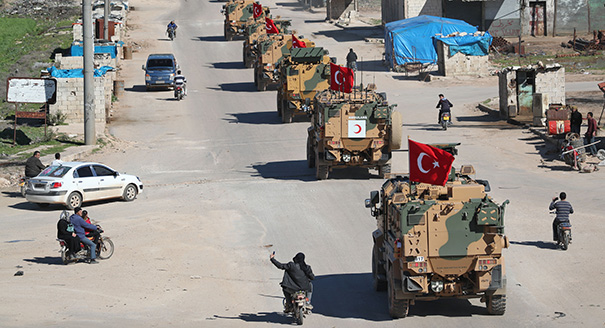The unconventional diplomatic and military choreography over northeastern Syria continues unabated between Ankara and Washington, and it involves European states as well, albeit more discretely. Meanwhile, Russia and Iran have kept supporting the approach of Syrian President Bashar al-Assad’s regime. As always, different players have different stakes in the game.
Looking at the realities in the field, the prominent development during the past few weeks has been Russia’s massive delivery to Syria of military supplies, including different missile types, through an air bridge to its Hmeimin airbase near Latakia. This has been carried out by large transport planes flying directly over Turkish territory. Ironically, these flight plans imply Ankara’s acquiescence.
The Russian objective embodied in the deal with Turkey over Idlib Governorate was always explicit: that remaining jihadis should not be allowed to return to Russia or anywhere else inside Syrian or Iraqi territory. Turkey’s position in the deal was delicate from the beginning, to say the least. By now it seems that Moscow wants a quick “solution” by way of an all-out offensive on the jihadis, irrespective of the humanitarian crisis that this is triggering. Civilian populations displaced by the current bombing campaign are probably around 200,000, if not higher, and many have gathered along the border with Turkey’s Hatay Province in makeshift camps, which offer little in terms of humanitarian supplies. In addition, the level of security for the internally displaced Syrians is low, all the more so as Turkey doesn’t intend to open its border to would-be refugees.
Meanwhile, east of the Euphrates River, Syrian Kurdish forces of the People’s Protection Units (YPG), the main element of the Syrian Democratic Forces (SDF) alliance, are holding their ground with the support of a reduced contingent of U.S. forces and a contingent of French forces. From open sources, it is clear that discussions are continuing between the United States and Turkey over the establishment of a safe zone of unspecified depth along the Syrian-Turkish border between the Euphrates and Tigris Rivers.
On May 22, James Jeffrey, the U.S. special representative for Syria engagement and the special envoy to the Global Coalition to Defeat ISIL, told the U.S. House Foreign Affairs Committee: “I was in Ankara earlier this month, to negotiate an arrangement regarding a so-called safe zone in northeast Syria in an effort to deescalate any potential for violence. That diplomatic effort continues apace as we continue to focus on finding solutions.”
While no details have emerged on how such a zone would be implemented, it is striking that these U.S.-Turkey discussions continue despite friction between Washington and Ankara. Some of the issues that need to be discussed are whether Turkish forces would be present in the zone, the size of U.S. forces, the location of YPG-SDF forces, and monitoring mechanisms.
If a U.S.-Turkey agreement on a safe zone is agreed upon and implemented, some European countries could be involved in different ways in a resolution of the Syrian crisis. One form of involvement, at least in theory, could be limited military participation by European countries in order to partly supplement the reduction of U.S. forces on the ground. Jeffrey declared on June 4 that the safe zone arrangements would not involve any European troops. However, the remaining U.S. forces in northeastern Syria will be bound to focus their activities on the border with Turkey if the safe zone agreement is to be implemented efficiently. This means that European forces already present in northeastern Syria, or indeed additional forces, will concentrate their actions further south of the area currently under SDF control. This is where other European countries could conceivably be considering deploying small military contingents, especially in areas where European jihadis are being held in temporary prison camps.
Air cover will also be important. The German press has been speculating recently on a possible continued role for the German Air Force. It is currently carrying out air surveillance missions out of Jordan, but the mission will come to an end in the autumn. Whether the political conditions in the Bundestag—and since June 2 the added complexity of a change of leadership in the Social Democratic Party, the key partner of the current governing coalition—will allow for this extended commitment remains an open question.
On the political level, the French and German leaders already participated in a one-off Istanbul summit on Syria in October 2018 with the Russian and Turkish presidents. Although it was not successful in reaching a breakthrough on a political settlement, nor was it popular in Washington, the summit had at least one advantage: It brought home the benefits of a direct dialogue with the dominant military player in Syria, Russian President Vladimir Putin, on a crisis that will not be resolved without his approval. A new iteration of such a summit remains a possibility, yet is unconfirmed to this day.
Several factors could yet add to the volatility of the current situation. One is the divergence of views between Ankara and Moscow over operations in Idlib Governorate. Another is the extremely heated atmosphere in the U.S.-Turkish relationship due to the possible deployment of Russian S-400 missiles in Turkey and a U.S. decision to cease training Turkish F-35 pilots at U.S. air bases.








